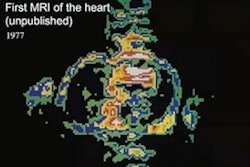The presence of left ventricular changes revealed on cardiac MRI can help predict 10-year negative cardiovascular outcomes, researchers have reported.
"In a low- to intermediate-risk cohort, [we found that] left ventricular remodeling at cardiac MRI predicted 10-year cardiovascular outcomes, with indexed left ventricular mass and left ventricular mass-to-volume ratio being predictive in male and female participants, respectively," wrote a team led by Jonathan R. Weir-McCall, MD, of the University of Cambridge in the U.K. The findings were published November 5 in Radiology.
Left ventricular remodeling is a known marker of cardiovascular risk, and it occurs early in the development of cardiovascular disease -- even preceding risk factors like hypertension. Although increased left ventricular mass (LVM) (a consequence of left ventricular remodeling) is associated with an increased risk of negative cardiovascular events, long-term follow-up studies regarding LVM in individuals at low- to intermediate-risk of disease are scarce, the team explained. It also noted that cardiac MRI is the go-to exam for evaluating left ventricular remodeling, with elevated LVM suggesting an increased risk of heart failure, coronary heart disease, and stroke.
Weir-McCall and colleagues explored any sex-specific associations between left ventricular mass measured on cardiac MR imaging with negative cardiovascular outcomes in individuals with a less than 20% 10-year risk of cardiovascular disease (CVD). They conducted a study that included 1,495 individuals older than 40 years with no history of CVD and a 10-year risk of the disease of less than 20% (of these, 925 were women and 570 were men). All participants underwent cardiac MR imaging between June 2008 and February 2013 as part of a study called the Tayside Screening for Cardiac Events (TASCFORCE). The investigators indexed LVM to body surface area and calculated the LVM-to-volume ratio; they then tracked negative cardiovascular events over a decade via national electronic health records.
The group found the following:
- In women, LVM was linked to older age, higher blood pressure, current smoker, and higher cholesterol level, while in men, it was associated with older age and higher blood pressure.
- In women, LVM-to-volume ratio was linked to negative cardiovascular events (hazard ratio [HR], 2.3, with 1 as reference) while LVM was not.
- In men, the finding above was the opposite: LVM was associated with cardiovascular events (HR, 3.2), while LVM-to-volume ratio was not.
"Our study showed that in this low- to intermediate-risk group of asymptomatic volunteers, LV mass helped predict future CVD events and therefore could be a sensitive marker for such events," the group concluded.
In an accompanying commentary, Jérôme Garot, MD, PhD, and colleague Suzanne Duhamel, MD, both of the Institut Cardiovasculaire Paris Sud in Massy, France, noted that "ventricular remodeling and responses to overload are different in women and men." They urged further research, writing that "the physiologic pathways leading to LVM progression in volunteers without known CVD remain incompletely elucidated, and the results of this study taught us that these relationships will need to be studied in sex-specific populations."
The complete study can be found here.



















